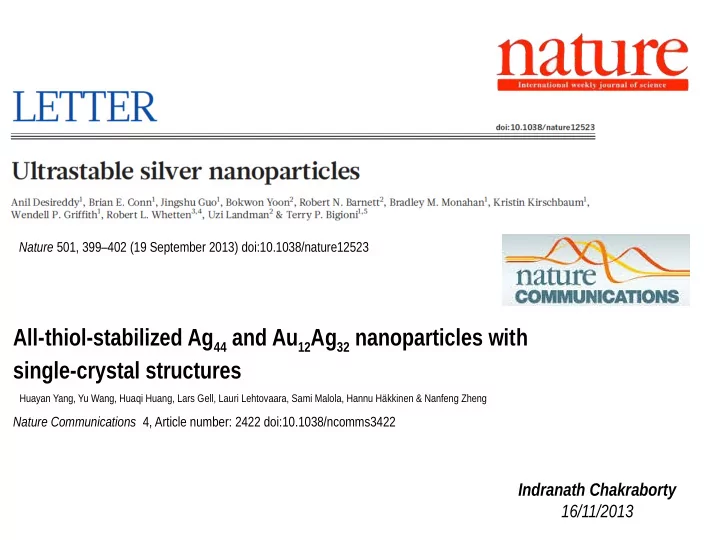

Nature 501, 399–402 (19 September 2013) doi:10.1038/nature12523 All-thiol-stabilized Ag 44 and Au 12 Ag 32 nanoparticles with single-crystal structures Huayan Yang, Yu Wang, Huaqi Huang, Lars Gell, Lauri Lehtovaara, Sami Malola, Hannu Häkkinen & Nanfeng Zheng Nature Communications 4, Article number: 2422 doi:10.1038/ncomms3422 Indranath Chakraborty 16/11/2013
Background
Background
In these papers They have developed a new approach to the preparation of ultrastable silver nanoparticles in semi aqueous solution, which uses a protecting ligand shell of p-mercaptobenzoic acid (p-MBA), and p-flurothiophenol. Crystal structure of Ag 44 cluster was determined which is the first report on thiol protected silver cluster. Detailed analysis of crystal structure suggest the unusual hollow cage in core and completely different staples surrounding the cluster core for this cluster. The stability was compared with most stable Au 25 cluster. Crystal structure of (Au-Ag) 44 cluster was also determined using suitable ligands.
Synthesis and characterization Gel electrophoresis of Ag clusters run on the same gel. (A) Glutathione-capped Ag clusters, with Ag32(SG)19 indicated. (B) p-MBA-capped Ag clusters, with three major bands observed. (C) Absorption spectra of the three prominent gel bands, offset for clarity. The spectrum of a M4Ag44(p-MBA)30 solution is shown for comparison (dotted line). The differences can be attributed to an incomplete separation of bands 1 and 2.
Synthesis and characterization (a) ESI-MS of the final product without size separation shows that only one species is present, with other peaks accounted to different charge states, fragments and non-specific dimerization. (b) Isolated Ag 44 L 30 4- ions spontaneously fragment into Ag 43 L 28 3- and AgL 2 - when desolvated, where L is p-MBA. Inset: the experimental data (black) were fit (blue) using a simulation of the Ag 44 L 30 4- ion isotopic distribution (red bars) and that of its Na salt (green bars). Only the heights of each distribution were adjusted during the least-squares fit, which also includes a small vertical offset and accounts for external calibration.
Synthesis and characterization Tandem mass spectrometry of Ag 44 L 30 4- ions. Once mass selected, fragmentation of the ions was observed for different trap collision energies, as noted.
Crystal Optical micrographs of typical crystals of M4Ag44(pMBA)30 clusters using (left) episcopic and (right) diascopic illumination
Crystal structure Na 4 Ag 44 (p-MBA) 30 [M 12 Ag 32 (SR) 30 ] 4-
Crystal structure Representative Crystal structure of [M12Ag32(SR)30]4- cluster. a, The overall structure of the [Au12Ag32(SPhF2)30]4- cluster. b, The two-shell Au12@Ag20 core of the cluster. c, The structure of the surface [Ag2(SPhF2)5] motif. d, The arrangement of six [Ag2(SPhF2)5] motif units on the surface of the cluster. Color legend: orange sphere, Au; green sphere, Ag; yellow sphere, S; gray stick/sphere, C. All hydrogen and fluorine atoms in the cluster are omitted for clarity.
Crystal structure The representative packing structures of [M12Ag32(SR)30]4- clusters with PPh4 + counterions. a, Compound 2, (PPh4)4 [Au12Ag32(SC6H3F2)30]; b, Compound 5, (PPh4)4[Ag44(SC6H4CF3)30]. The PPh4 + counterions are highlighted in the space-filling style for better visualization. Color legend: orange sphere, Au; green sphere, Ag; yellow sphere, S; pink sphere, P; gray sphere, C; cyan sphere, F. All hydrogen atoms are omitted for clarity.
Crystal structure b M-M bond length in the M12 shell (M=Au, Ag); c Ag-Ag bond length in the Ag20 shell; d M-Ag bond length between the M12 and Ag20 shell; e Ag-S bond length between Ag and thiolate.
Comparative UV/Vis spectra Optical properties of [M12Ag32(SR)30]4- clusters. UV-Vis absorption spectra of a [Ag44(SR)30]4- b [Au12Ag32(SR)30]4- clusters with different surface thiolates. Calculated spectrum of [Ag44(SPhF2)30]4- is shown in a for comparison
Summary Successful synthesis of Ag 44 cluster using different ligands and single crystal analysis of them. The cluster is having an unusual hollow cage of 12 atoms which is further surrounded with another 20 atom cage to form a Ag 12 @Ag 20 core which was encapsulated with 6 Ag 2 (SR) 5 staples in an octahedral fashion. Silver has the maximum coordination number of 10 (for the core silver atoms). Counter ion has important role for getting good co-crystals. Optical spectra were computed and compared with the experimental one. Au-Ag alloy cluster was synthesized and crystallized using the same method.
Recommend
More recommend